How Digital Transformation Enables Autonomous Polymer Operations
This keynote address by Alex Reed, co-founder and CEO of Fluence Analytics, focused on the critical business aspects driving the bottom line in polymer manufacturing.
Since many facilities and feedstock suppliers are spread across several geographical areas, there are inevitable variations in quality. The fact that resources to control those variations depend on individual facilities presents a challenge to polymer manufacturers as they strive to compete across their product ranges.
End-users require increasing performance levels from materials as applications continually expand and push the limits of existing assets and technologies. This is especially important as the workforce ages and tribal knowledge has not been adequately captured and quantified. An essential facet of digital transformation is expanding the available quantitative process data to improve decision-making. Real-time measurements, analytics, and process control are significant factors in the operational side of digital transformation.
This address delved into novel, real-time measurements of polymer properties. These real-time insights drive advanced analytics and controls that lead to autonomous, end user-optimized manufacturing while enabling the next generation of materials and sustainability.
Polymer Industry Basics
Alex began with an eye-opening industry overview that demonstrated how integral polymers have become to our lives on a day-to-day basis. Ranging from commodity materials to specialty materials, it is a $1 trillion industry.
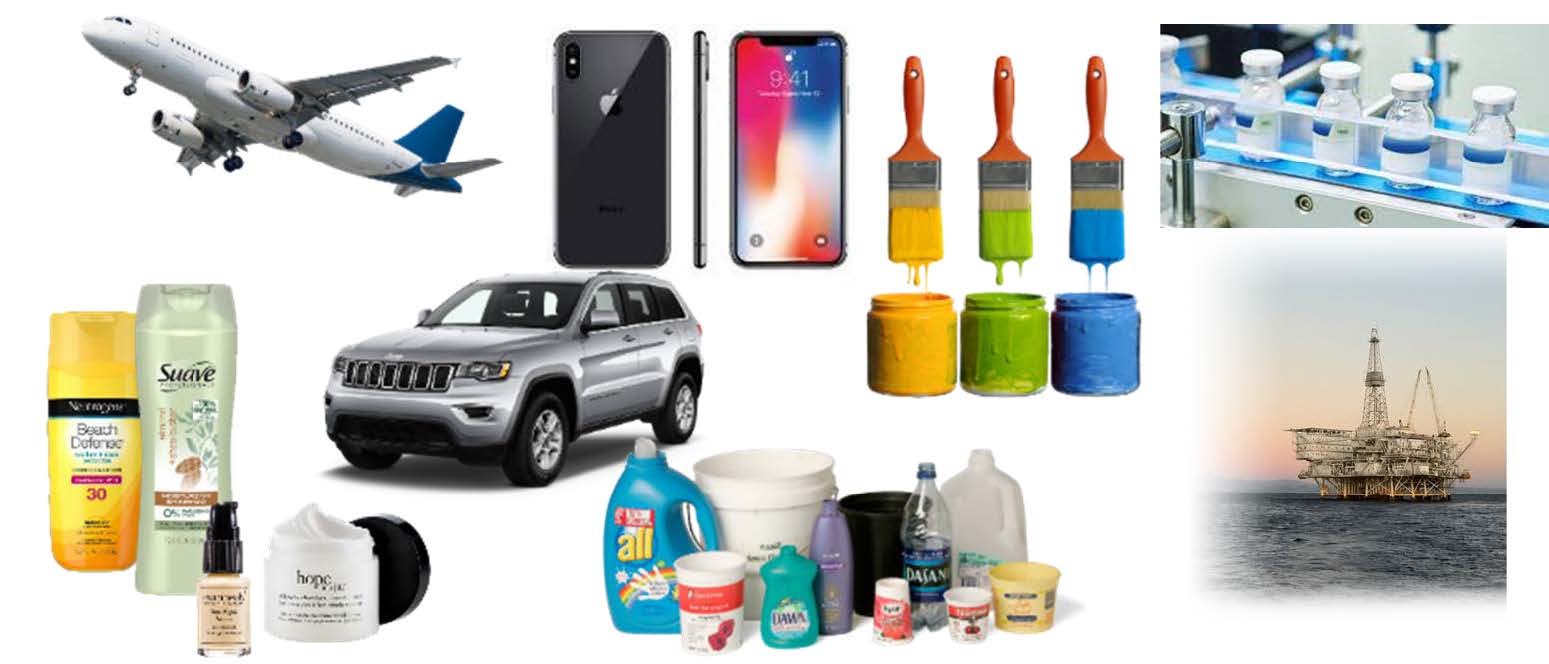
The $1 trillion polymer industry makes our modern lives possible.
Continuous processing and high volume production at large, integrated petrochemical sites characterize the commodity polymers sector. Typical of any commodity market, the focus is on cost, yield, and quality enhancements. However, in commodity polymers, emphasis is shifting to be more specialized.
The prevailing characteristics of the specialty commodities sector are batch processing and low volume, higher-margin production. Farther up the value chain, this sector leverages specific feedstocks, which are primarily petrochemicals, but some are bio-based, too.
A manufacturer typically has a lengthy product mix—a large number of SKU's—with many applications. This sector is fast-paced and innovative. Players are constantly updating products to meet new customer requirements and looking for that competitive edge. Meanwhile, like the commodities sector, they must also focus on cost, yield, and quality enhancements.
Polymer Industry Challenges
A new trend that everyone in the industry is experiencing is the requirement for continuous optimization to stay competitive. At the minimum, staying competitive requires reducing costs, increasing margins, improving quality, developing new products, and gaining market share. Everyone is working on launching the next great product.
Companies are also streamlining processes and using existing assets to increase yields. An Environmental Sustainability Goals (ESG) angle is new. Companies are reducing waste, reducing their environmental footprints, and finding ways to enable a circular economy. The more they can do with less, the better.
Today, there is so much rapid change. To optimize operations and profits, companies are looking at the economics of each plant and each business unit. They are also optimizing their supply chains and expanding visibility in that area. They are dealing with shifting demographics in the workforce and a business environment with continuous growth and change. Meanwhile, the existential sustainability issue is front and center. Dealing with the COVID-19 pandemic topped off all these challenges.
Autonomous Operations
All these challenges are leading us in one direction: autonomous operations. How do autonomous operations—or industrial autonomy—address each of the challenges?
For operational and profit optimization, that means data-driven operational feedback control. It uses more and more data to understand specific problems, solve them, and drive improved economics. Autonomy provides accurate, hyper-connected supply chains that are genuinely on-demand. In workforce demographics, companies are shifting from qualitative tribal knowledge, which has kept certain assets running for a long time, and trying to layer in as much as possible to make that quantitative.
To enable a circular economy, autonomous operations comprise the first step, which is to maximize efficiency. In a rapidly changing environment, autonomous operations provide the high responsiveness required to adapt and move quickly. Finally, COVID made it clear that we need remote-ready operations. Companies must continue operating and managing the supply chain without everyone working in a single location.
In a maturity model that Yokogawa has made popular, the path to autonomy can be categorized into six stages. The first three range from manual to automated. Most of the industry resides in one of these
stages. A few have progressed to semi-autonomous operations in which there is a mixture of autonomous operations and automated assets with human orchestration.
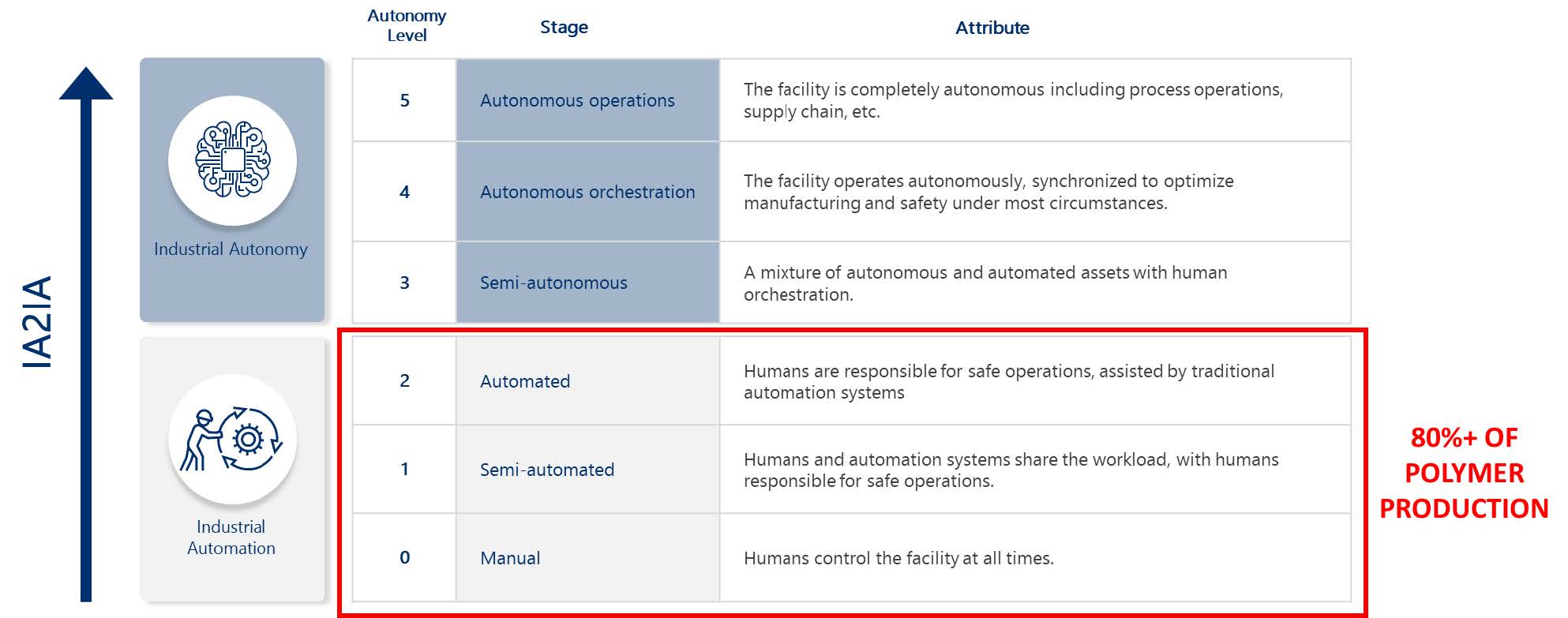
On the path from industrial automation to industrial autonomy (IA2IA), 80% of the industry still resides in one of the early stages.
Autonomous Operations Enablers and Use Case Examples
Four key enablers of autonomous operations and associated qualifying questions are listed below:
- Real-time measurements and data – are we recording all the parameters required for data-driven control?
- "Autonomous-ready" assets – are our assets modern enough for autonomous control?
- Data analytics and knowledge algorithms – do we know what to do with the data to optimize production?
- Autonomous control – can we convert insights into autonomous control?
Alex proceeded to a use case for the crucial first step. That is a multi-pronged, multi-solution issue for most of the industry. IIoT sensing, intelligent measurement, and wireless communications technologies are enablers, but the issue remains a matter of deployment for most companies. In polymer production, what are the essential properties to measure?
Today, those are molecular properties such as the microstructure (or monomer configuration), molecule architecture, molecular weight, chain length, monomer composition and sequence, and morphology. Key mechanical properties are the melting point, tensile strength, viscoelasticity, and optical properties. Ultimately, the producer needs to know how the material is going to perform in its end-use application.
There is a variety of technologies for such measurements as calorimetry and chromatography in the lab. A problem, currently, is a natural bottleneck when the producer relies on off-line, single-point lab measurement. A lag time, which could be hours, even for a single data point, will make it difficult to control the process.
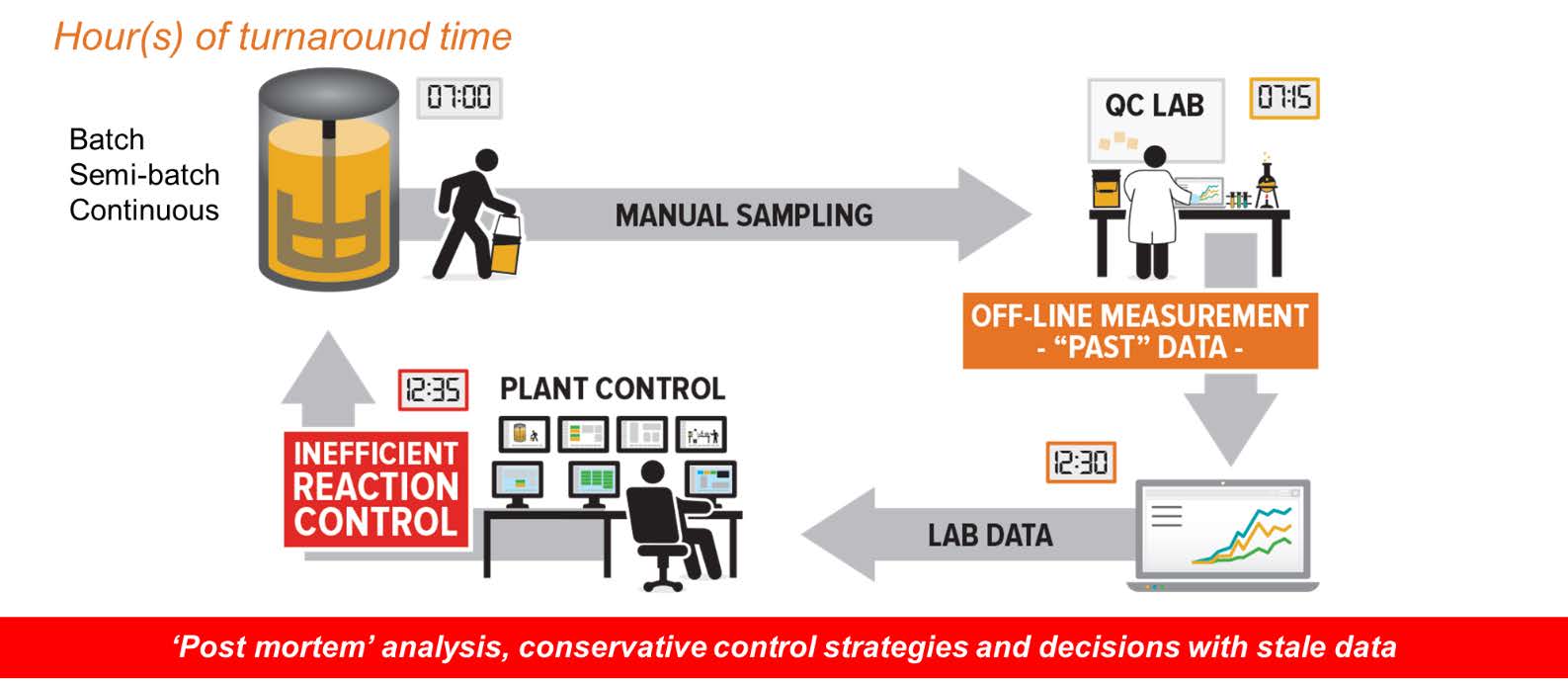
Manual sampling and lab measurements could introduce hours of lag time for critical measurements.
To reduce the lag time, researchers at Tulane University and the spin-off company, Fluence Analytics, developed a technology, Automatic Continuous Online Monitoring of Polymer Reactions (ACOMP), to measure polymer properties in real-time. ACOMP uses automatic analysis software that performs rapid deviation detection, which allows a human-in-the-loop to intervene and optimize.
By monitoring all parameters in real-time, ACOMP quickly detects when the product batch is trending out-of-spec. In polymer production, process upsets such as feed rate issues and catalyst issues require rapid responses from the control system. An hour's lag time would result in an out-of-spec batch. The optimized process control provides plant digitization, reduced cycle times, improved yields, and consistency.
In another example, ACOMP can reduce the reaction time in a batch process, whereas a batch with excess reaction time would suffer quality degradation. In addition, the reduced cycle time improves the total capacity of the asset.
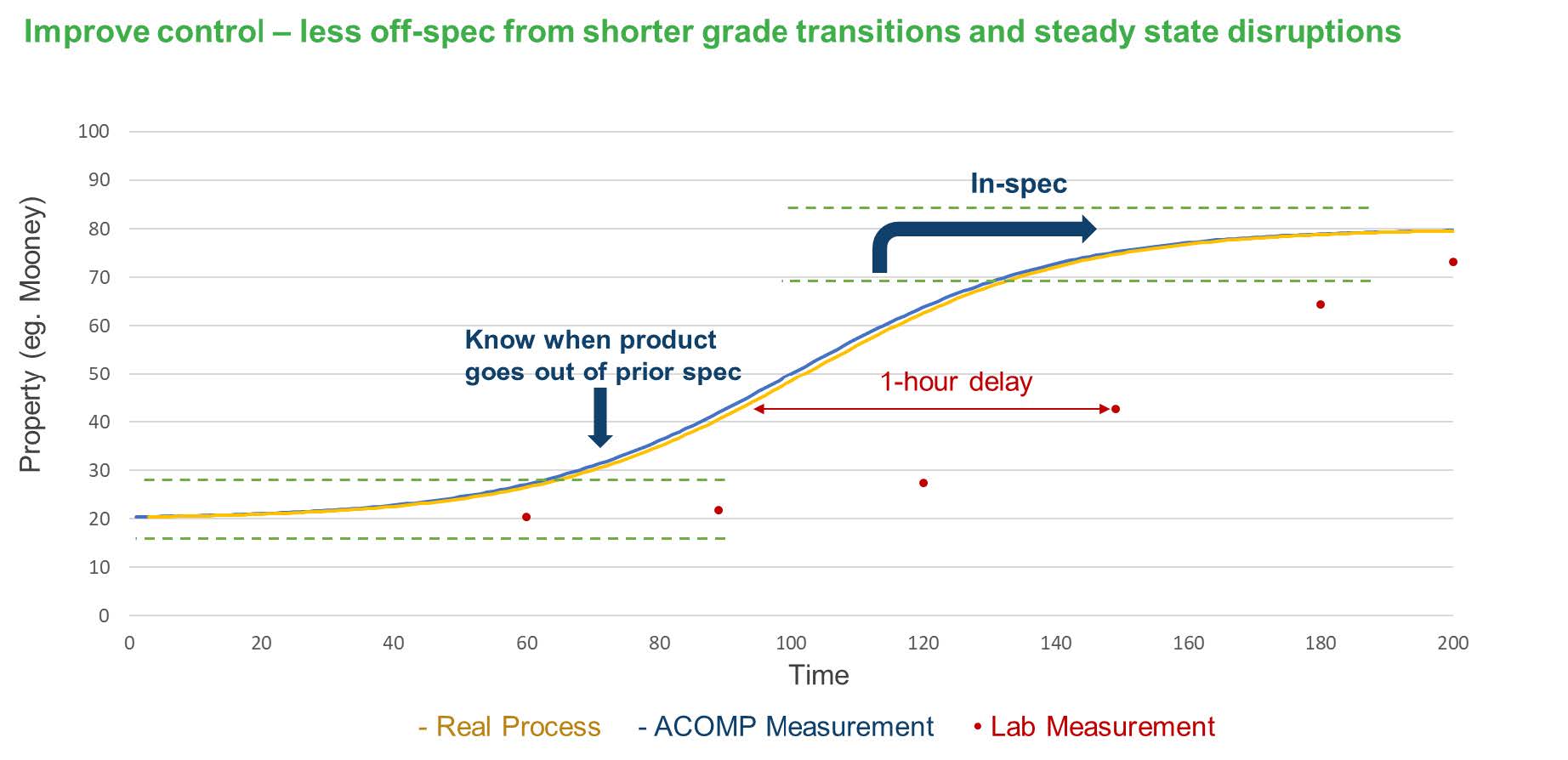
By quickly intervening when an out-of-spec trend occurs, ACOMP maintains the batch within spec—whereas a lab measurement with a one-hour lag time would result in an out-of-spec batch.
Once the company has the measurements in place, the next key enabler is a digital ecosystem with "autonomous-ready" assets. It consists of fully connected, intelligent sensors, pressure transmitters, flowmeters, a modern control system, automation-capable actuation hardware, and a digital data infrastructure.
The first two enablers lead to the third, which includes analytics and knowledge algorithms to contextualize the data. This is where the company puts the data to work to optimize production. The real-time process information from the measurement & control system and the analyses from the lab all reside in the historian. Also available is the enterprise resource planning (ERP) information such as inventory and raw materials plus visibility to the supply chain. Pulling that information together enables the modeling, troubleshooting, control strategies, and decision-making required for optimization.
The fourth enabler, autonomous control, is a matter of converting the insights that the data analytics and knowledge algorithms provide. Using the enabling measurement technology combined with data analytics and insights, decisions are made autonomously. Unlike the system in the first example, in which the human-in-the-loop responds when the process is trending out-of-spec, autonomous control uses predictive detection and takes corrective action in a timelier manner. A human-in-the-loop is unnecessary.
Conclusion – the Digitalization Journey to Autonomous Control
Achieving autonomous control is a journey. It won't happen overnight. Starting with new data sets in production, even with human-in-the-loop control, will yield a very high ROI over the prior status quo. While the first step provides "quick wins," which will help onboard most of the organization, it represents only 20% of the total value of autonomous control.
Realizing the other 80% requires continuing the journey to contextualize the data and turn the insights into control and new products. Contextualizing the data with process knowledge combines human intelligence with enabling technologies that convert new datasets into actions.
Taking that further involves combining algorithms and human insights with data using a machine learning correlation engine to update and improve control continually. The insights push the chemistry into new products.
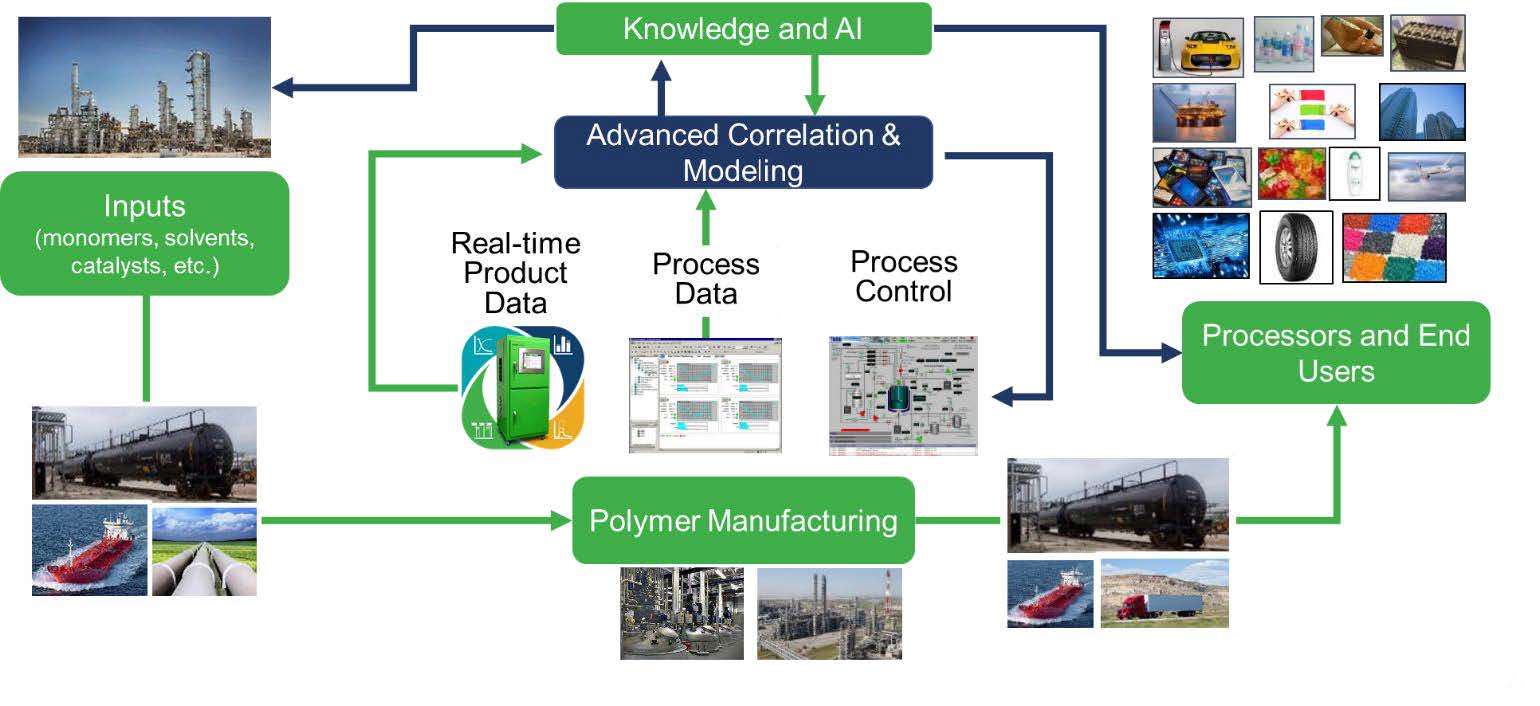
The manufacturer achieves dynamic optimization by contextualizing real-time data and control and connecting with end-users and the supply chain.
Autonomous control enables dynamic manufacturing optimization by connecting the polymer producer with end-users and the supply chain. Real-time product data, process data, and process control comprise the foundation for autonomous operation with knowledge algorithms, advanced correlation, and modeling. Autonomous control essentially allows any manufacturer to operate as though the business is in a commodity market.
Operating and competing effectively in this changing world in the next decade will require that t 80% or more of the producers achieve at least one of the industrial autonomy levels.

Competing effectively in this changing world in the next decade will require at least 80% of the producers to achieve industrial autonomy.
Related Products & Solutions
-
Digital Transformation Consulting
DX Consulting provides advice and support with its global industry experience and vast technical expertise stemming from Yokogawa’s trusted digital technology and KBC’s years of improvement consulting.
-
Digital Twin
A digital twin is the key to effective decision making, providing deeper analytics technology and strategies to maximize profitability.
-
Digital Transformation
- Yokogawa's wide process manufacturing knowledge/expertise
- Digital transformation solutions for a better future for our customers